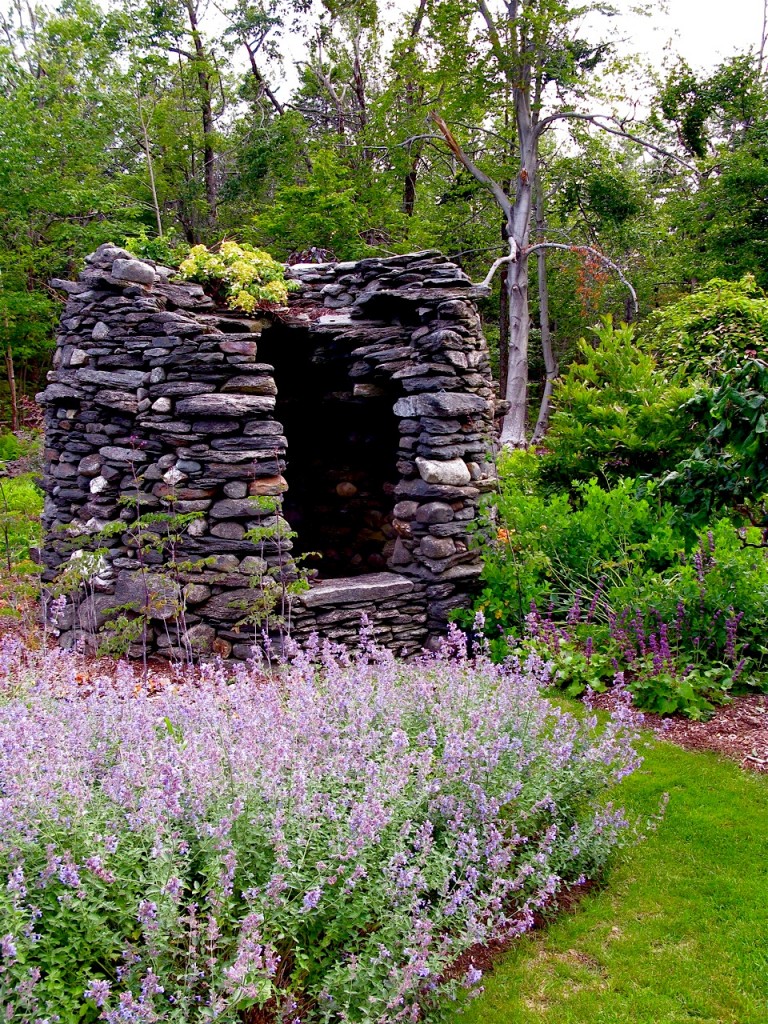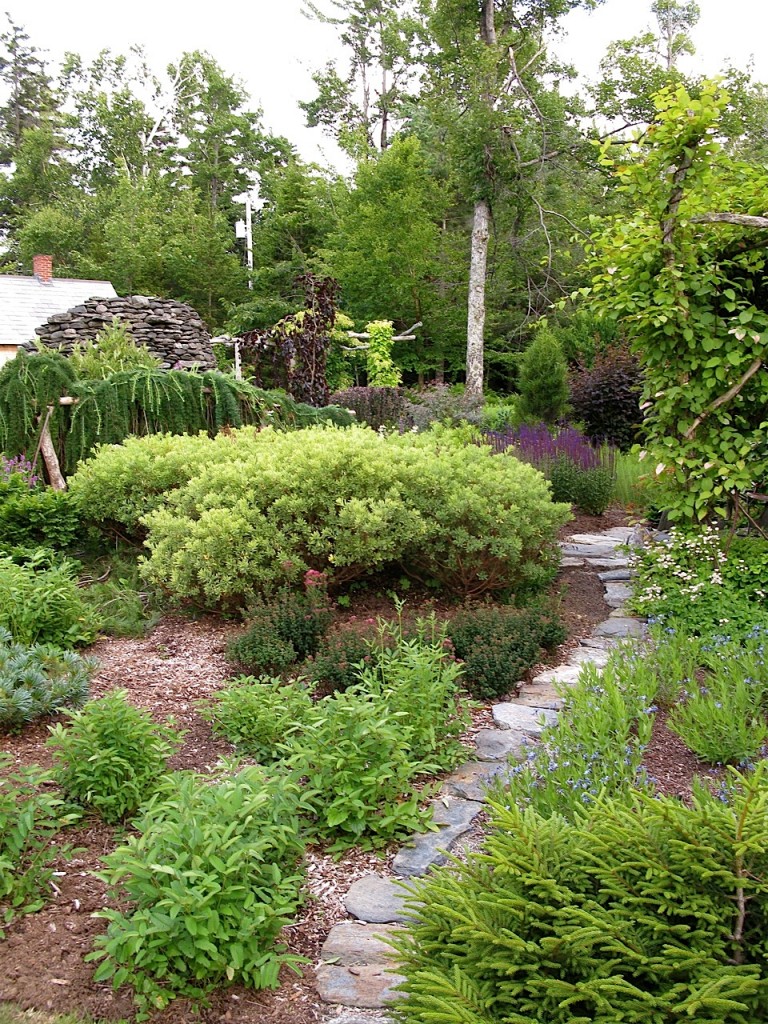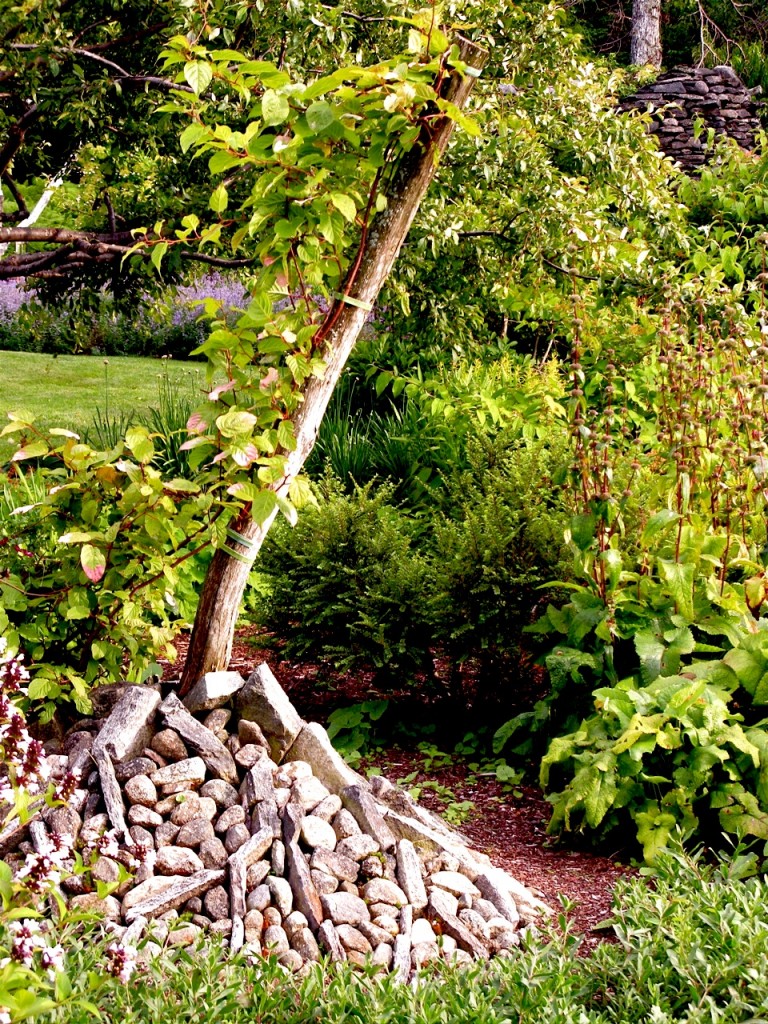Design Inspiration: A lesson in planning, editing and restraint… my visit to the private garden of Phyllis Odessey and Peter Mauss.
~ The Stone Garden House sculpture, by artist Dan Snow, at the  Mauss~Odessey Garden
Beautiful, isn’t it? Visiting this magical garden last weekend, created by my friends Phyllis and Peter, was truly inspirational. Phyllis Odessey is an incredibly talented garden designer with a knack for making large open spaces seem both intimate and calm. Her beautiful garden seduces with serpentine, alluring paths, dramatic sculpture, unusual specimen trees and shrubs, and sweeping plantings in a serene palette. Over the course of many years, Phyllis and Peter have created a living work of art on their property. This is my favorite kind of garden; designed with a singular vision, and developed patiently over time. It seems that each time I visit, a new area has been developed or refined, and yet the garden always retains its overall harmony. This garden is a perfect example of how to grow a space slowly, while maintaining an overall sense of garden style.
Even for professional gardeners and designers, it is difficult to practice restraint with plantings. Phyllis is an excellent editor, and this is one of the reasons her garden is such a success. While strolling down her newly laid stone path, (yes, she did it herself), I was impressed with the artistry of the flowing line, and the way the new walkway was planned to separate and edge a sweep of bearberry, (arctostaphylos uva-ursi), from the rest of the garden. Overall, this garden is large, and yet it is never overwhelming to the eye. Why is this? Careful observation reveals one of the keys to success is mass plantings of carefully chosen perennials in a limited palette. The Mauss-Odessey garden is a perfect example of how to successfully manage a large space.
I visit many private gardens as a consultant, and the most common design dilemma I encounter is a lack of over-all structure and flow. Many gardeners have a habit of visiting nurseries and plant sales on impulse, falling in love with a half dozen or more plants, and bringing them all home. Once back in the garden, things are hastily planted without a plan and quickly forgotten. Repeat. Repeat. Repeat. The end result of this compulsive shopping is often a patchwork quilt carved out of lawn; a chaotic hodge-podge rather than a soothing garden. Sometimes, a gardener is lucky enough to have an intuitive sense of space. When this happens, (and it is rare), the plant collecting becomes a whimsical but orderly garden. For most people however, it is essential to plan out a space before planting gardens, in order to avoid feeling overwhelmed and disappointed later on.
When trying to create a sense of calm in your garden, it is wise to take a cue from successful designers like Phyllis Odessey. Look at your space carefully before you head out to the garden center. Are you in the habit of buying one of this or two of that on impulse? The next time you are tempted by a plant sale, try to remind yourself of the photographs pictured here. When shopping for plants, instead of buying 14 different perennials, try buying at least seven of one kind. In order to do this, of course, you will need to do a bit of planning first. Know the size of your space. Take measurements and sketch an outline of your garden. Check your soil condition and sunlight. Â Make a rough plan to help guide you in your purchases and keep it in your wallet. This will be the first step in training yourself to practice the kind of restraint you need to in order to create a garden like the one pictured here.
Considering vertical space is another important aspect of successful garden design. In a garden of any size, it is critical to think beyond ground level. Shrubs, trees, vines and structures are essential to three dimensional garden space. Many works of art are included in Phyllis and Peter’s garden. Some of the artistic structures were created by the gardeners themselves, and other pieces were created by friends. There are hydrangea-wound pergolas and kiwi vine-clad-huts throughout the garden to stroll through and pause beneath. Living works of art, such as a weeping larch and pendulous beech, are used as dramatic focal points, drawing the eye up and out. Weight and substance are given to this garden with the addition of stonework. A large sculpture, pictured above, was created as a major garden feature by artist Dan Snow. Â The mass of this dark and mysterious shelter is softened by airy cat mint (nepeta), sage and delicate meadow rue (thalictrum). Climbing hydrangea, (h. petiolaris), planted on the reverse of the structure, is slowly winding its way over the top, lending an organic touch to the stone.
When I returned home from this spectacular garden I was filled with a sense of calm, (I am sure the champagne helped with this as well), and a determination to practice more restraint in my own space through careful editing. I have resolved to look around with a critical eye. Is something weak or dying? Time to get ruthless. And what about that long, chaotic border/holding tank? Time for some editing this fall. Â Visiting a well-designed garden is always an inspiration, and a great-way to jump-start new plans for your own space.
~ Masses of perennials in rich colors make for a dynamic, yet soothing garden experience ~
~ Â One of the softly curving paths winding through the Mauss-Odessey garden ~
~ Turned~Leaf Sculpture by artist Dan Snow ~
For more information about Phyllis Odessey, and her design process, visit her website and blog at www.phyllisodessey.com. Peter Mauss and Dan Snow have collaborated on two beautiful and inspirational books, In the Company of Stone, and Listening to Stone. Both of these books are available through independent book sellers, and Amazon online. Interested in reading more about stone work? I hope to feature an article on the subject later this year. Stay tuned.
***
~ Article and photographs copyright Michaela H. 2009 ~
***



